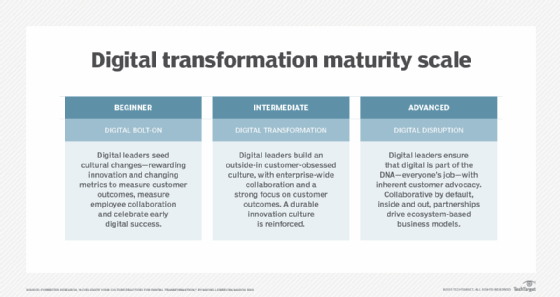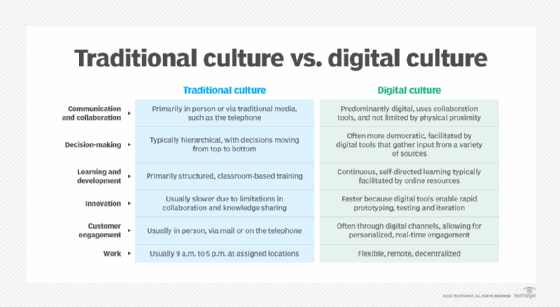digital culture (original) (raw)
What is digital culture?
Digital culture refers to the behaviors, practices and values that develop from the use of digital technologies.
A broad term, digital technologies include smartphones, social media, digital collaboration tools, enterprise content management, cloud infrastructure and software as a service as well as digital environments -- such as the internet -- that form the basis of the modern digital world.
The growth of digital technology use across society at large, including inside companies big and small, ensures the continued prominence and evolution of digital culture. Linked to this is a fundamental shift in how billions of people communicate, work, learn and entertain themselves. Not surprisingly, this shift has created changes in societal structures and norms.
What does it look like?
In organizational or corporate settings, the use of non-analog, "traditional" processes are fading, and digital cultures are rising. For example, teams rely on digital services such as Slack, Microsoft Teams, Google Meet and Zoom for collaboration and meetings, regardless of employee location. Digital culture also embraces remote and hybrid work. It lets employees contribute from almost anywhere. The idea of remote work is not only accepted, but it's also proven a more productive alternative to in-office work.
Digital culture also grasps the importance of and relies on analytics, the methodical computational study of data. In an organization that embraces digital culture, all recruitment, hiring and onboarding processes are digital. In addition, learning and development are available via online training modules and webinars.
Digital culture alters human interactions and impacts customer experience. The traditional nine-to-five telephone call for support is now the exception. Customer service is conducted through digital channels such as chat, messaging and social media.
Why is digital culture necessary for digital transformation?
Digital transformation refers to the integration of digital technologies into an organization's products, day-to-day processes and strategic initiatives. Its objective is to enhance employee engagement and improve service delivery among the workforce, its partners and its customers.
Digital culture underpins digital transformation by fostering the mindsets, behaviors and values required for an organization to fully integrate new technologies and ways of working.
Successfully completing a digital transformation means changing an organization's culture. Digital culture encourages the adoption of digital tools, innovation and collaboration, based on an underlying openness to change and continuous learning in general.
Without a supportive digital culture, organizations face significant barriers to meaningful change, resulting in a digital transformation that is slow, costly and/or incomplete.

Figure 1. Having a digital culture places organizations higher on the digital transformation maturity scale.
The benefits (and possible pitfalls) of digital culture
A strong, well-entrenched digital culture provides numerous benefits to an organization, but savvy managers recognize certain risks inherent in embracing digital culture too.
The benefits include the following:
- Enhanced communication and collaboration. Digital culture promotes the use of real-time tools for instantaneous communication and collaboration, making it easier for organizations to work together, regardless of where employees are located.
- Streamlined user adoption and change management. In a digital culture, individuals are more comfortable using digital tools and technologies. Digital culture nurtures a mindset more open to change, smoothing digital transformation processes in general. Furthermore, it lets organizations better handle digital disruption when new digital technologies – artificial intelligence, for example – require adaptability from a business.
- Continuous learning and improvement. Digital culture supports ongoing skill development and learning, ensuring a company stays current with technological advancements and digital transformation efforts.
- Improved efficiency. A common attribute of embracing digital culture is automation of routine tasks, which reduces human error and increases productivity and overall efficiency.
- Innovation. A digital culture encourages employees' creativity and experimentation, from which fresh ideas, methods and approaches develop to build products and improve services and interactions.
- Resilience. Organizations with a strong digital culture are quicker to react to and recover from disruptions of any kind.
On the other hand, there are risks when embracing digital culture:
- Digital divide. Individuals in an organization who remain uncomfortable with or incapable of using digital technology cannot consistently contribute to a digital culture.
- Overreliance on technology. Excessive dependence on digital tools creates operational vulnerabilities, especially in the face of emergent technical issues or failures.
- Superficial interactions. Repeated and exclusive use of digital communication can degrade the human ability to forge connections, stunt an individual's emotional intelligence and dull the recognition and interpretation of nuanced communication signals such as body language.
- Distraction. Constant digital connectivity and information overload can fracture human attention spans, reduce concentration and impair overall productivity.
Traditional culture vs. digital culture
There are clear differences between traditional and digital culture across several activities, as listed in Figure 2:

Figure 2. There are many differences between a traditional culture and a digital culture.
Considerations for a strong digital culture
Development of a strong digital culture requires careful planning and thoughtful action. Among the key considerations for a strong digital culture are the following:
- Creating clear digital strategies. A digital strategy is foundational to a strong digital culture. It provides direction and clarity, setting the stage for technology's central role in achieving business goals.
- Management involvement. Successful executives lead by example, endorsing digital tools and practices on a day-to-day basis. For instance, managers can use digital communication tools for company-wide announcements.
- Employee engagement. Immersing all employees in the digital shift is critical to establishing a strong digital culture. Solicit employee feedback, consider workers' concerns and involve them in decision making where possible. For example, create channels for feedback on digital tools, and involve employees in beta testing new platforms.
- Encourage collaboration. Individuals who feel connected are empowered to collaborate. Keep communication open, clear and multidirectional. Use digital tools to facilitate information sharing and collaboration, and regularly remind employees of the purpose and benefits of digital culture.
- Prioritize inclusion. A successful digital culture is inclusive. All employees, regardless of their digital literacy levels, must be included in the transformation process and have access to the required education and training.
- Careful customer-experience consideration. Not only does focusing intently on customer experience improve products and services based on customer insights, but it also ensures user-friendly technology, enhancing overall customer satisfaction.
- Evaluation and recognition. Measure digital initiatives' success and acknowledge achievements. For example, use analytics to track digital project outcomes, and celebrate successes in adopting new digital methods.
This was last updated in October 2023
Continue Reading About digital culture
- Instilling a culture of digital transformation
- How IT leaders can drive digital innovation
- 10 digital transformation benefits for business
- 12 must-read digital transformation books in 2023
- 11 signs of toxic workplace culture
 What is cloud transformation and how do you get started?
What is cloud transformation and how do you get started?  By: Kinza Yasar
By: Kinza Yasar  5 tips for building a cybersecurity culture at your company
5 tips for building a cybersecurity culture at your company  By: Jerald Murphy
By: Jerald Murphy  corporate culture By: Cameron Hashemi-Pour
corporate culture By: Cameron Hashemi-Pour  Digital dexterity explained: Everything you need to know
Digital dexterity explained: Everything you need to know  By: Amanda Hetler
By: Amanda Hetler